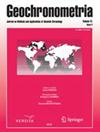Schmidt hammer exposure dating for brick masonry
IF 0.9
4区 地球科学
Q3 Earth and Planetary Sciences
引用次数: 1
Abstract
Abstract This research investigates the validity of the Schmidt hammer exposure dating (SHED) technique as a complementary means to date monuments according to the evaluation of the brick decay from masonry exposed to climatic conditions. The degree of surface weathering, I5 (%) is calculated as an indicator of the ageing effect and compared to the absolute age of the churches constructed between 1600 and 1795. This paper discusses the results obtained with such a method and the use of the technique within the framework of historical research. Tests were done on exterior church walls built between the 17th and 19th centuries. All the churches were located within the limited geographical area of Hainaut, in the south of Belgium. Results indicate that SHED provides encouraging results for buildings constructed between 1790 and 1895, with a linear correlation (R2>0.8) between surface weathering of brick façades and their ages. However, the weathering indices show high variability of values for the period 1750−1790, which may confirm that the variable qualities of bricks were in use during this period of time because of the different production techniques. As such, the results highlight the probable influence of the entire manufacturing and construction process and technical improvements in traditional brick-making.施米特锤曝光测定砖砌体的年代
摘要:本研究考察了施密特锤暴露测年(SHED)技术作为一种补充手段的有效性,根据砖石暴露在气候条件下的砖衰变的评估来确定纪念碑的年代。表面风化程度,I5(%)被计算为老化效应的指标,并与建于1600年至1795年之间的教堂的绝对年龄进行比较。本文在历史研究的框架内讨论了这种方法所获得的结果以及该技术的使用。测试是在17世纪到19世纪之间建造的教堂外墙上进行的。所有的教堂都位于比利时南部Hainaut有限的地理区域内。结果表明,SHED对1790 ~ 1895年间建造的建筑物提供了令人鼓舞的结果,砖砌体表面风化与它们的年龄呈线性相关(R2 >.8)。然而,风化指数显示1750 - 1790年间的数值变化很大,这可能证实了由于不同的生产技术,在这段时间内使用了不同质量的砖。因此,结果突出了整个制造和施工过程以及传统制砖技术改进的可能影响。
本文章由计算机程序翻译,如有差异,请以英文原文为准。
求助全文
约1分钟内获得全文
求助全文
来源期刊

Geochronometria
地学-地球科学综合
CiteScore
2.20
自引率
0.00%
发文量
1
审稿时长
>12 weeks
期刊介绍:
Geochronometria is aimed at integrating scientists developing different methods of absolute chronology and using them in different fields of earth and other natural sciences and archaeology. The methods in use are e.g. radiocarbon, stable isotopes, isotopes of natural decay series, optically stimulated luminescence, thermoluminescence, EPR/ESR, dendrochronology, varve chronology. The journal publishes papers that are devoted to developing the dating methods as well as studies concentrating on their applications in geology, palaeoclimatology, palaeobiology, palaeohydrology, geocgraphy and archaeology etc.
 求助内容:
求助内容: 应助结果提醒方式:
应助结果提醒方式:


